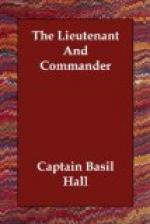Dr. Young and Hadley, the great authorities on the subject, are both wrong in their conclusions.[3] Where Hadley obtains his “experience” he does not tell; but certain it is, that no sailor who ever crossed the equinoctial line could possibly have furnished him with two of his principal statements. The Trades are not strongest near the equator, as he states, nor when they reach that district do they blow along it, or in a parallel direction, but almost always at right angles to it.
If the earth had no motion on its axis, but were surrounded as at present with an atmosphere, and if the sun moved round and round it exactly above the equator, without varying his declination, the following effects would ensue: That portion of the earth lying, say thirty degrees, on each side of the equator, being more exposed to the action of the sun than those further from it, would become much warmer; while the superincumbent air, being greatly heated by the contact, would expand, or become specifically lighter, and would consequently rise. The adjacent air, both on the north and south, being cooler, and, of course, heavier, would rush in to supply the place of the heated air. This air coming from the regions beyond the tropics would, in its turn, be heated, and rise on reaching the warmer equatorial regions, giving place to a fresh supply, which, it is easy to see, must be furnished by the descent of that portion of air formerly heated at the equator, raised into the cold regions of the sky, and forced into a regular circuit by fresh elevations of heated air. All these and many other interesting results are clearly developed in Daniell’s Meteorological Essays, a book which every one at all interested in such inquiries will find it advantageous to study. The first edition of this work was published in 1823, some years after these speculations had been forced upon my notice by a long course of service between the tropics.




